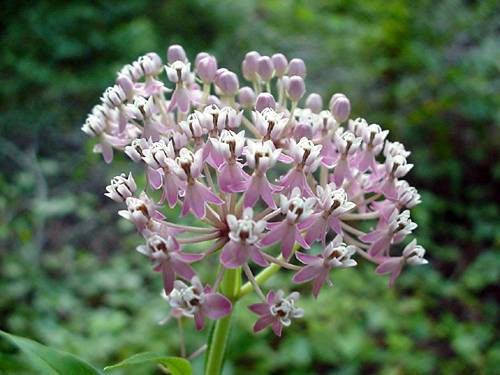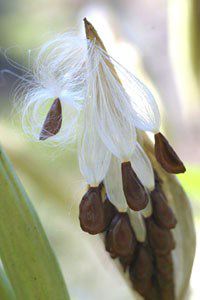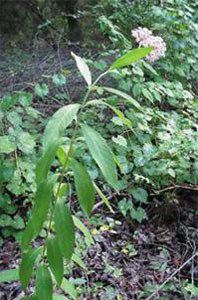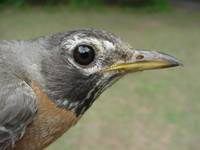|
|
|||
|
THIS WEEK at HILTON POND Back to Preceding Week; on to Next Week |
|
|
|||
|
THIS WEEK at HILTON POND Back to Preceding Week; on to Next Week |
|
SWAMP MILKWEED For years we've hoped that a brisk autumn wind would blow some seeds of Purple Milkweed, Asclepias syriaca, onto Hilton Pond Center, not only because we think it's an attractive blossom but also because it serves as host plant for caterpillars of the Monarch butterfly. We also covet the brilliant orange stands of Butterfly Weed, A. tuberosa, a related plant that flourishes along roadsides near--but not on--the property. We probably could accelerate the advance of these desirable plants by sowing their seeds, but we always seem to forget to collect any pods as they ripen each fall. 
All photos & text © Hilton Pond Center Nonetheless, the Milkweed Family (Asclepiadaceae) IS represented at Hilton Pond Center by one species, Swamp Milkweed, A. incarnata. Over the past decade, breeze-borne seeds of this plant have found their way to the edge of the pond, where moisture-loving Swamp Milkweed has established several small colonies. Like all its relatives, Swamp Milkweed has a distinctive flower that is shaped rather like an hourglass (right)--wide at the top and base, but constricted in the middle. The "base" is formed by five pigmented sepals that fold away from the rest of the flower, which includes five united petals. Each petal forms a "hood" over a stamen, or "horn," and the relative configurations of these two structures are useful in identifying various milkweed species. In the case of Swamp Milkweed, the horn is longer than its hood and curves away from it toward the flower center. Within each milkweed flower there are two ovaries, which is why the plant's awl-shaped seed pods occur in pairs. These pods--green and often prickly to the touch (below left, photographed in early September)-- Swamp Milkweed grows to four feet in height (below right), its flowers forming an umbel-like cluster at the top of the stalk; side branching may occur in large, robust plants. Like the rest of its relatives, Swamp Milkweed's showy multiple flowers are easily found by bees and butterflies, which dine on milkweed nectar. But, as noted above, milkweeds play an even more important role for the larvae of some butterflies, most notably the Monarch.  ..... ..... The milkweed gets its name from its white sap--although Swamp Milkweed is far less sappy than many of its relatives. Milkweed sap is a viscous fluid that flows through the plant's vascular system and oozes out when a stem or flower is damaged (bottom photo). Some animals decline to browse on milkweed foliage because of the bitter sap, which is laden with glycosides that are at least mildly toxic. However, Monarch caterpillars in particular thrive on milkweed and concentrate those glycosides in their own bodies--which in turn makes them unpalatable to potential predators. We don't know for sure, but maybe the spread of Swamp Milkweed over the last ten years at Hilton Pond Center helps explain why there's been a decline in Blue Jays during that period. After all, as lepidopterist Lincoln Brower once demonstrated on film, the best way to make a Blue Jay throw up--and maybe depart for good--is to feed it a Monarch caterpillar that has been munching on the toxic leaves of milkweed. 
All text & photos © Hilton Pond Center Comments or questions about this week's installment? NOTE: Be sure to scroll down for an account of all birds banded or recaptured during the week, as well as some other interesting nature notes. "This Week at Hilton Pond" is written & photographed You may wish to consult our Index of all nature topics covered since February 2000. You can also use the on-line Search Engine at the bottom of this page. For a free, non-fattening, on-line subscription to "This Week at Hilton Pond," just send us an E-mail with SUBSCRIBE in the Subject line. Please be sure to configure your spam filter to accept E-mails from hiltonpond.org. |
|
Make direct donations on-line through
Network for Good: |
|
|
LIKE TO SHOP ON-LINE?
Donate a portion of your purchase price from 500+ top on-line stores via iGive: |
|
|
Use your PayPal account
to make direct donations: |
|
|
(Sexes look alike among young birds except male's tail is black, female's is brown, as below)
The following species were banded this week (15-21 July): Ruby-throated Hummingbird--6* * = Includes at least one Recent Fledgling |
WEEKLY BANDING TOTAL YEARLY BANDING TOTAL (2001) 63 species 799 individuals BANDING GRAND TOTAL (since 28 June 1982) 122 species 39,082 individuals 
American Robin (female)
NOTABLE RECAPTURES WITH ORIGINAL BANDING DATES: Northern Cardinal (1) 11/17/95
All photos & text © Hilton Pond Center |
Back to Preceding Week; on to Next Week
|
Up to Top of Page Current Weather Conditions at Hilton Pond Center |
 You can also You can alsopost questions for The Piedmont Naturalist |
Join the |
Search Engine for |
|
|